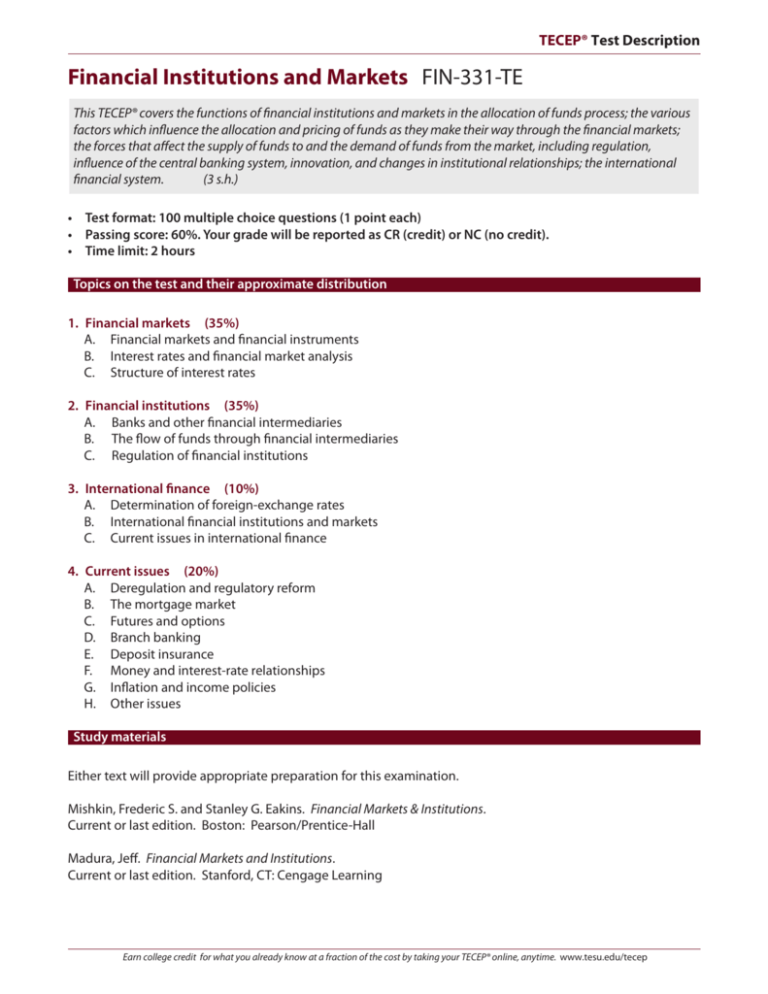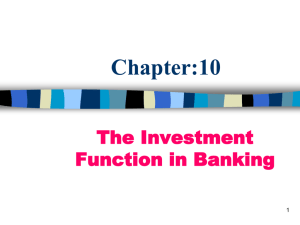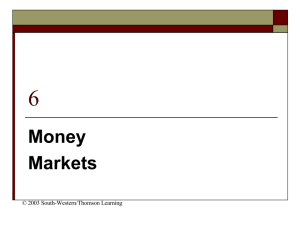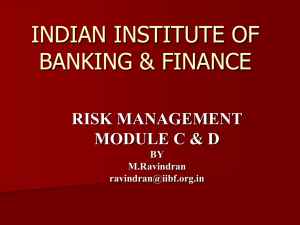
TECEP® Test Description
Financial Institutions and Markets FIN-331-TE
This TECEP® covers the functions of financial institutions and markets in the allocation of funds process; the various
factors which influence the allocation and pricing of funds as they make their way through the financial markets;
the forces that affect the supply of funds to and the demand of funds from the market, including regulation,
influence of the central banking system, innovation, and changes in institutional relationships; the international
financial system.
(3 s.h.)
• Test format: 100 multiple choice questions (1 point each)
• Passing score: 60%. Your grade will be reported as CR (credit) or NC (no credit).
• Time limit: 2 hours
Topics on the test and their approximate distribution
1. Financial markets (35%)
A. Financial markets and financial instruments
B. Interest rates and financial market analysis
C. Structure of interest rates
2. Financial institutions (35%)
A. Banks and other financial intermediaries
B. The flow of funds through financial intermediaries
C. Regulation of financial institutions
3. International finance (10%)
A. Determination of foreign-exchange rates
B. International financial institutions and markets
C. Current issues in international finance
4. Current issues (20%)
A. Deregulation and regulatory reform
B. The mortgage market
C. Futures and options
D. Branch banking
E. Deposit insurance
F. Money and interest-rate relationships
G. Inflation and income policies
H. Other issues
Study materials
Either text will provide appropriate preparation for this examination.
Mishkin, Frederic S. and Stanley G. Eakins. Financial Markets & Institutions.
Current or last edition. Boston: Pearson/Prentice-Hall
Madura, Jeff. Financial Markets and Institutions.
Current or last edition. Stanford, CT: Cengage Learning
Earn college credit for what you already know at a fraction of the cost by taking your TECEP® online, anytime. www.tesu.edu/tecep
TECEP® Test Description
Sample questions
1. What is the primary function of large, diversified brokerage firms in the money market?
a. To sell money market securities to the Federal Reserve for its open market operations
b. To buy money market securities from corporations that need liquidity
c. To make a market for money market securities by maintaining an inventory from which to
buy or sell
d. To buy T-bills from the U. S. Treasury Department
2. If bad credit risks are those that most actively seek and receive loans from financial intermediaries, what
problem does this cause the financial intermediaries to face?
a. Moral hazard
b. Adverse selection
c. Free-riding
d. Costly state verification
3. All financial intermediary institutions in the intermediation market
a. buy primary securities and sell secondary securities
b. borrow short and lend long
c. borrow in small denominations and lend in large
d. buy from brokers and dealers and sell to the public
4. What are Federal funds?
a. Treasury notes
b. Commercial bank deposits at the Federal Reserve
c. Federal Reserve assets
d. Vault cast of the Federal government
5. Which of the following statements always describes the relationship between current yield and
yield to maturity?
a. The current yield is higher.
b. The two yields are the same.
c. The yield to maturity reflects the total return; the current yield only the cash return.
d. The yield to maturity should be used in comparing bonds which are to be held to maturity; the
current yield for comparing bonds which are to be sold before maturity.
6. A bank is solvent as long as it
a. has enough capital to pay off depositors
b. has mostly good loans
c. does not experience a run on its deposits
d. is able to meet all demands by depositors for payment
7. As opposed to most other debt instruments, mortgage loans tend to
a. charge lower interest rates
b. be of larger denomination
c. pay interest less frequently
d. be repaid over the life of the loan
Earn college credit for what you already know at a fraction of the cost by taking your TECEP® online, anytime. www.tesu.edu/tecep
TECEP® Test Description
8. In most variable-rate mortgages, the homebuyer
a. assumes none of the interest rate risk
b. assumes all of the interest rate risk
c. shares the interest rate risk with the lender
d. does not repay the principal until maturity
9. A futures contract is an agreement to trade an asset
a. in the future at a price determined today
b. today at a price prevailing at some future date
c. in the future at a price prevailing in the future
d. today at a price determined today
10. What is the object of fixed exchange rates?
a. To prevent exchange rates from changing
b. To prevent misallocation of economic resources
c. To eliminate the economic fluctuations that result from short-run, self-reversing forces
d. To prevent the effects of one country’s inflationary policies from spreading to other countries
11. If a bank has more rate-sensitive assets than rate-sensitive liabilities, then a(n) ________ in interest rates
will ________ bank profits.
a. increase; increase
b. increase; reduce
c. decline; increase
d. decline; not affect
12. Which of the following has done the most to prevent bank failures?
a. Federal deposit insurance
b. Bank examinations
c. Separation of investment and commercial banking
d. Restrictions on branch offices
13. The term structure of interest rates shows
a. how interest rates vary over time
b. the pattern of interest rates over the long-term business cycle
c. security yields ranked by default risk structure
d. the relationship between maturity and yield for similar securities
14. If the yield on long-term securities is greater than the yield on comparable short-term securities,
the yield curve will be
a. positively sloped
b. negatively sloped
c. in the negative quadrant
d. undefined
15. In the process of deposit deregulation in the early 1980s, banks were allowed to
a. offer checkable deposits that paid implicit interest only
b. pay explicit market rates on savings and time deposits and limited interest on checkable deposits
c. pay below market explicit interest on savings and time deposits
d. pay explicit market rates on checking accounts
Earn college credit for what you already know at a fraction of the cost by taking your TECEP® online, anytime. www.tesu.edu/tecep
TECEP® Test Description
16. Classical interest rate theory states that rising interest rates will
a. increase the demand for money
b. decrease the demand for money
c. decrease investment expenditures
d. increase the quantity of saving
17. A central bank sale of ________ to purchase ________ in the foreign exchange market results in an
equal rise in its international reserves and the monetary base.
a. foreign assets; domestic currency
b. foreign assets; foreign currency
c. domestic currency; domestic assets
d. domestic currency; foreign assets
18. When does a negative yield curve tend to exist?
a. During a period of unemployment
b. During a period of inflation
c. During a period of deflation
d. During a period of full employment
19. As opposed to future contracts, forward contracts
a. are not standardized
b. involve an intermediary or exchange
c. have informal markets
d. make delivery more often
20. Which of the following is true of restrictions on branch offices?
a. National banks can establish branches in any state.
b. Unit banking is more common on the West Coast.
c. Branching laws are determined by each individual state.
d. Statewide branching is illegal in almost every state.
Answers to sample questions
1. c
2. b
3. a
4. b
5. c
6. d
7. d
11. a
12. a
13. d
14. a
15. b 16. d17. d
8. c
9. a
10. c
18. b
19. b
20. c
Earn college credit for what you already know at a fraction of the cost by taking your TECEP® online, anytime. www.tesu.edu/tecep












